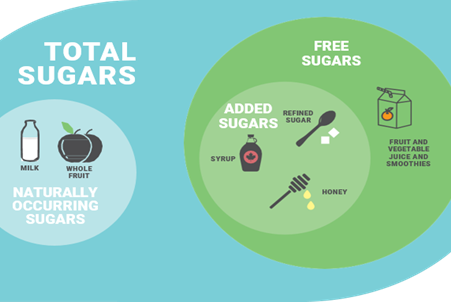Sugar is a type of carbohydrate. Carbohydrates are classified into two basic groups, complex and simple. Carbohydrates break down in the body to become a source of energy called glucose.
There are 2 types of sugar, together, these two types make up a person's *TOTAL SUGAR INTAKE*
1. Naturally occurring sugar - Sugar that is found naturally in whole plant food.
2. Free sugars (added sugars) - Sugars that have been added to food or drink to sweeten it. These could be sugar added during the processing of food, when preparing food, added to hot drinks or to breakfast cereals, found in processed food and in pasta sauces or salad dressing. Free sugars also include sugars that are naturally present in honey, syrups, and fruit juices.

To see if a food has free sugar, check the ingredients list for sugar. Only free sugars will be listed on the ingredients list. Common sugars listed include raw sugar, honey, brown sugar, cane sugar, dextrose, fructose, sucrose, lactose, glucose, malt syrup, molasses, maple syrup, agave nectar, barley malt and caramel. The higher the ingredient is on the list, the larger the quantity of it in the product. You can also read food labels to check how many grams of sugar there are per 100g of food you consume.
The table below can serve as a guide to limiting the consumption of sugar when comparing food products and identifying whether food products contain high, medium, or low amounts of total sugar.
|
|
HIGH (per 100g) |
MEDIUM (per 100g) |
LOW (per 100g) |
|
Sugars (total)
|
Over 10g |
Between 5g-10g |
5g and below |
|
For breakfast cereals only
|
Over 15g |
Between 5g-15g |
5g and below |
Eating too many sugars can contribute to eating too many calories, leading to obesity. Obesity increases an individual’s risk of developing non-communicable diseases such as heart disease, type 2 diabetes, non-alcoholic fatty liver disease, metabolic syndrome, cancer and tooth decay.
The World Health Organisation recommends that the consumption of free sugars is less than 25 grams the equivalent of 6 teaspoons a day.
For further information visit our Publications page
